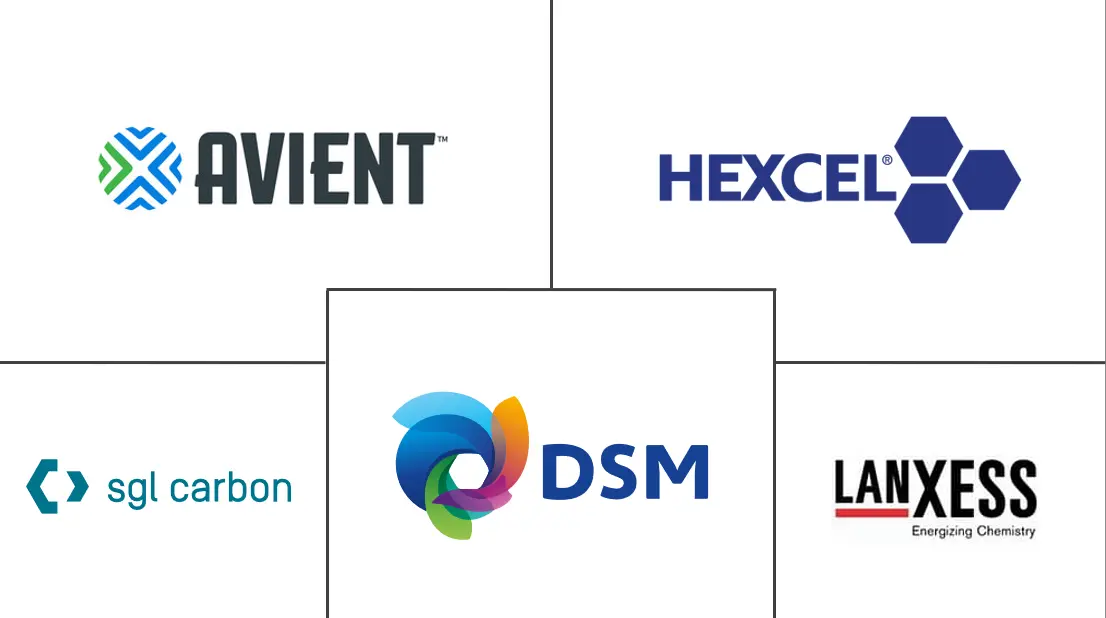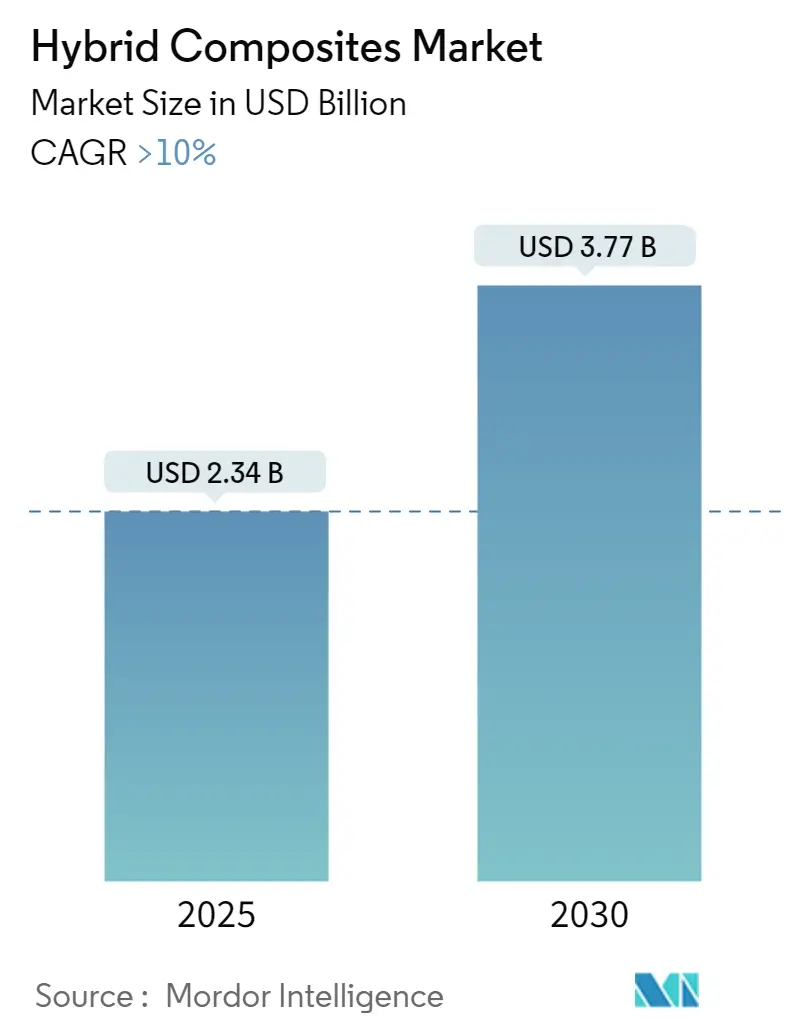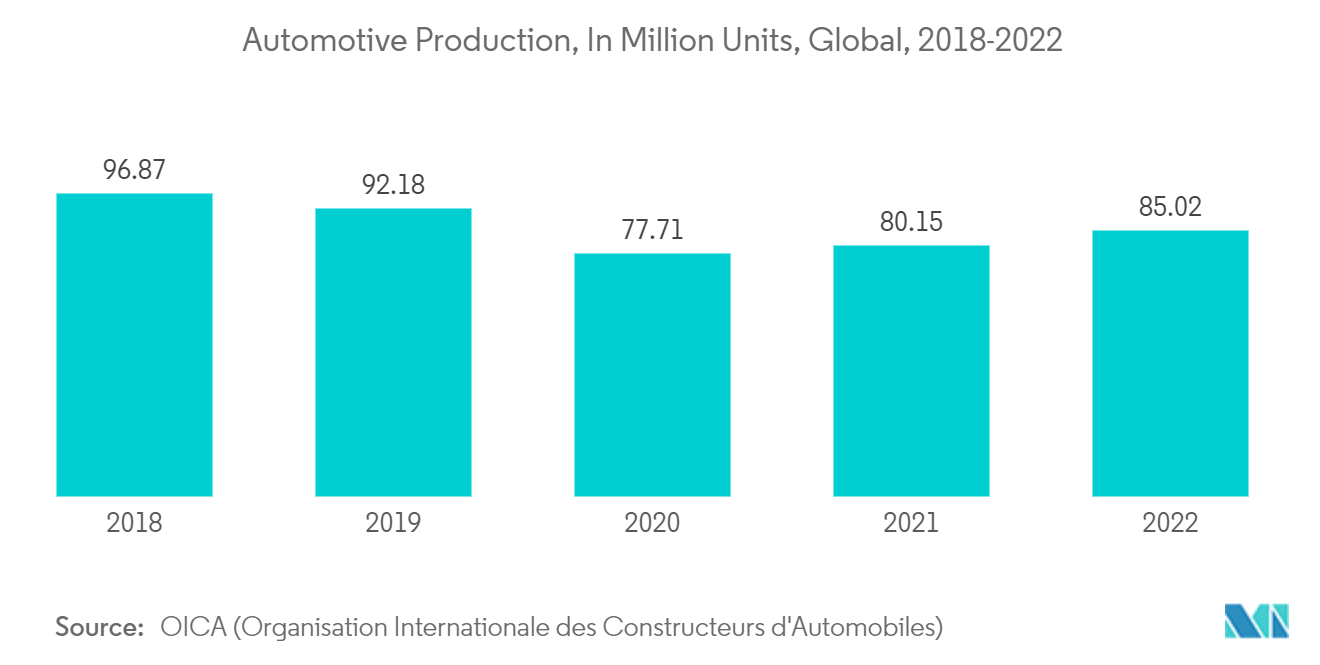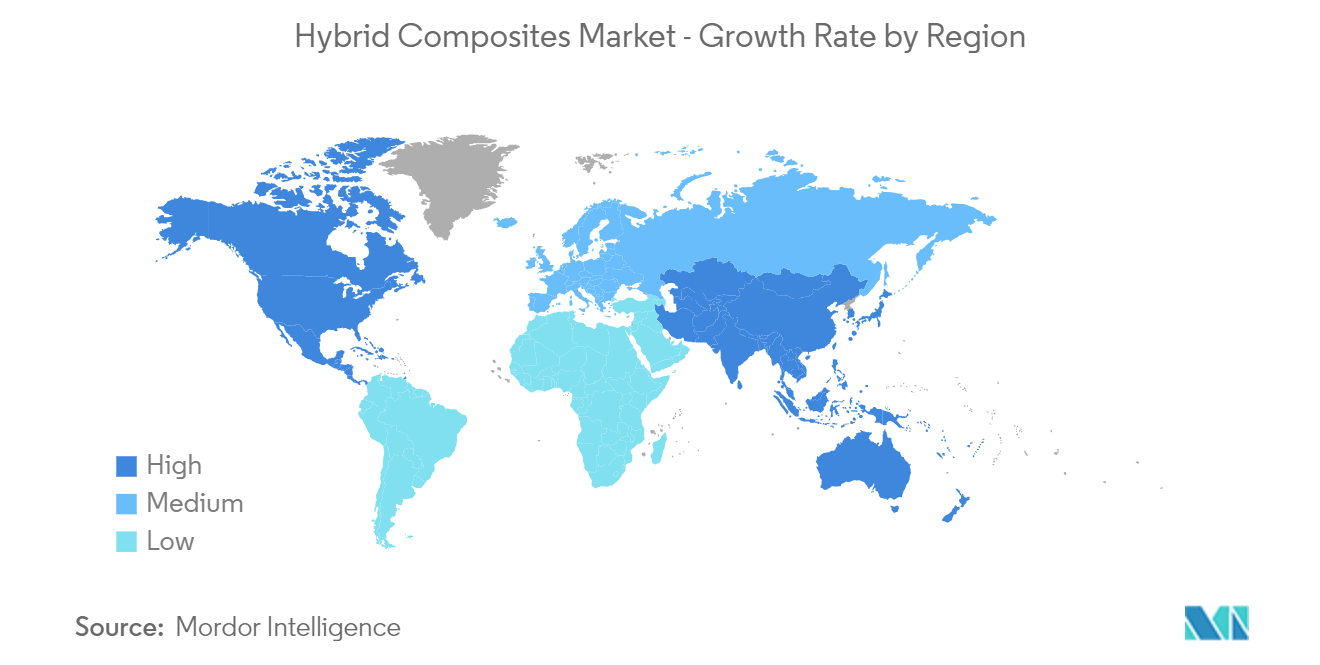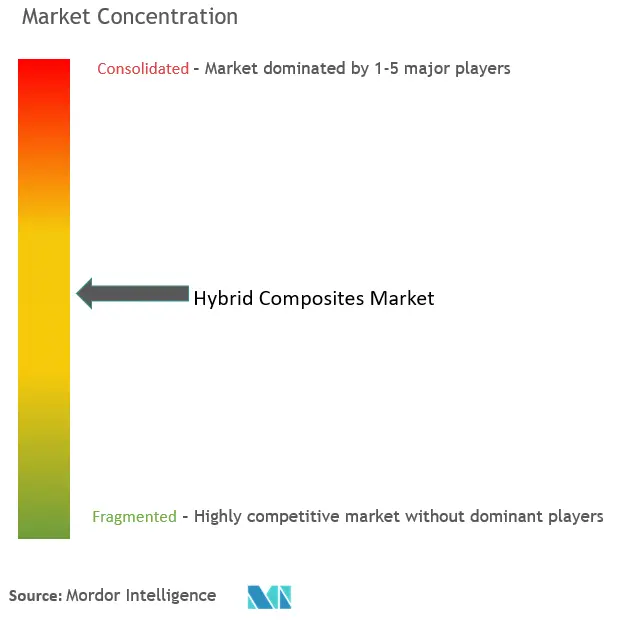Hybrid Composites Market Analysis
The Hybrid Composites Market size is estimated at USD 2.34 billion in 2025, and is expected to reach USD 3.77 billion by 2030, at a CAGR of greater than 10% during the forecast period (2025-2030).
The impact of the COVID-19 pandemic on the hybrid composites market was mixed. While it presented immediate challenges, it also highlighted the potential of these materials and triggered trends that could contribute to long-term growth.
Lockdowns and travel restrictions disrupted the flow of raw materials and finished products, leading to production delays and material shortages. Industries heavily reliant on hybrid composites, such as aerospace, automotive, and wind energy, experienced significant downturns due to travel restrictions and economic slowdown, dampening demand for material. On the flip side, the pandemic highlighted the need for advanced materials in medical devices and equipment, creating opportunities for biocompatible hybrid composites in prosthetics, implants, and surgical instruments.
- The growing adoption of composite materials in the light vehicle sector and compared to traditional composites, better properties exhibited by hybrid composites in comparison to the traditional composites is a major driving factor for the market studied.
- On the flip side, the processing and manufacturing of hybrid composites often involve complex and labor-intensive techniques, driving up costs and may act as a hindrance to the growth of the market studied.
- Exploring automation, digitalization, and additive manufacturing techniques for composite production can streamline processes, reduce costs, and improve product consistency can provide lucrative opportunities in the global market.
- Asia-Pacific is expected to witness the highest growth rate during the forecast period owing to the high demand from China.
Hybrid Composites Market Trends
Carbon/Glass to Dominate the Market
- The most commonly used hybrid composites are glass fiber-reinforced polymer (GFRP) and carbon fiber-reinforced polymer (CFRP) composites, followed by composites reinforced by aramid or natural fibers.
- Hybrid carbon fiber/glass fiber material is a lightweight and high-strength alternative for traditional fiberglass and metal applications in the automotive & transportation, building & construction, and other industrial markets.
- The hybrid material offers the performance benefits of carbon fiber at a cost similar to high-performance fiberglass.
- Increased application of hybrid composites in automation and fast-paced manufacturing processes meet mass production requirements in automotive and other sectors.
- According to the Organisation Internationale des Constructeurs d’Automobiles (OICA), in 2022, around 85.01 million vehicles were produced across the globe, witnessing a growth rate of 5.99% compared to 80.205 million vehicles in 2021, thereby indicating an increased demand for metal hoses from the automotive industry. In 2022, around 60 million passenger cars were manufactured worldwide, up nearly 7.35% compared to 2021.
- Users can get up to 90% of carbon’s benefits at a cost much lower than what they would have to incur in case of using carbon fiber.
- Parts made out of these hybrid composites provide a high strength-to-weight ratio and are devoid of corrosion. These have extended service life, requiring less maintenance. Their particular properties meet the needs of applications that lay utmost importance on safety and strength.
- In building and construction, many composite products and applications are gaining more and more traction thanks to their unique properties (e.g., corrosion resistance, insulation, lightweight). From composite rebars for reinforcing concrete to pultruded profiles for window frames and composite roofing tiles, composite products not only enable more sustainable designs but also provide an effective solution to repair, upgrade, or strengthen existing buildings, bridges, etc.
- As per JEC Composites, interest in recycling and reusing materials is high, and key players in the composites industry are involved in many initiatives. The application sectors are also setting ambitious goals in this area, e.g., Europe’s wind industry is committing to reusing, recycling, or recovering 100% of turbine blades by 2025.
- Owing to the factors mentioned above, carbon/glass fiber type is likely to dominate the market during the forecast period.
Asia-Pacific to Witness the Highest Growth Rate
- The infrastructure industry in Asia-Pacific has been growing at a healthy rate in recent times. Hence, it is estimated that the region will witness a tremendous growth rate in the cement board market over the assessment period.
- The Asia-Pacific region is currently experiencing high investments in residential and commercial construction, especially in China, Japan, Taiwan, and South Korea, and in developing economies such as India, Malaysia, Indonesia, and Vietnam.
- According to JEC Composites, In the future, long-term trends should resume, with economic growth driven by emerging Asia: China's growth is expected to exceed 5% CAGR per annum, higher than Europe and the US; India, Philippines, Indonesia, and Malaysia should grow at a comparable rate. In the mid-term (2021-2026), the composites market should resume growth in all regions, and there is still substantial potential for long-term growth, especially in Asia (energy, E&E, …).
- In automotive, these unique materials, combining the strengths of various fibers and resins, offer a winning combination of lightweight, enhanced performance, and improved fuel efficiency, leading to increased consumption of hybrid composites in the Asia-Pacific market.
- The Chinese automotive manufacturing industry is the largest in the world. The industry witnessed a slight growth in 2022, wherein production and sales increased. A similar trend continued in 2021, with production witnessing a 3% incline in 2022. According to the China Association of Automobile Manufacturers (CAAM), automotive production is expected to grow in the future, with companies like BYD, SAIC Motors, and more increasing their automotive production sales in the fuel-run and electric vehicles segment.
- According to the China Association of Automobile Manufacturers, Chinese automakers are anticipated to report sales of approximately 9.4 million electric vehicles and hybrids in the previous year, up from 6.9 million in 2022. The association further projects a continued increase in sales for 2024, reaching 11.5 million units.
- For Example, China's automotive giant BYD sold over 3 million battery-powered cars in 2023, of which both batteries and gasoline power 1.6 million fully electric vehicles and another 1.4 million hybrids. Together, that is a 62 percent increase over 2022. BYD is also making money, tripling its profit to USD 1.5 billion in the first half of last year, according to BYD.
- According to India Today, 4,108,000 cars were sold in the domestic market in 2023. This was the first time during a calendar year that over 4 million units were sold in the country. In 2022, the industry witnessed sales of 3,792,000 units. In India, major automotive manufacturers, like Maruti, Hyundai, Tata, Honda, and Mahindra, have shut down their production owing to the unsold stock. This is expected to have a substantial negative impact on India's automotive production in the near future.
- China has one of the largest healthcare sectors in the world. Under the 13th Five-Year Plan, the Government of China prioritized health and innovation, which is expected to increase investments in the medical device manufacturing sector during the forecast period. Additionally, due to the COVID-19 outbreak, investment in the healthcare sector has been gradually growing in the country.
- Hybrid composites can achieve exceptional strength-to-weight ratios, exceeding even steel in some cases. This makes them ideal for load-bearing structures, bridges, and earthquake-resistant buildings.
- China's growth is also fueled by rapid expansion in the residential and commercial building sectors and the country's expanding economy. China is encouraging and enduring a continuous urbanization process, with a projected rate of 70% by 2030. As a result, increased building activity in nations like China is projected to fuel the region's adhesive industry. All such factors tend to increase the demand for adhesives across the region.
- According to the National Bureau of Statistics of China, the value of construction output accounted for CNY 31.2 trillion (USD 4.5 trillion) in 2022, up from CNY 29.31 trillion (USD 4.2 trillion) in 2021. Moreover, as per the forecast given by the Ministry of Housing and Urban-Rural Development, China's construction sector is expected to maintain a 6% share of the country's GDP going into 2025.
- As per Invest India, the construction industry in India is expected to reach USD 1.4 Trillion by 2025, and the construction industry in India works across 250 sub-sectors with linkages across sectors and over 54 global innovative construction technologies identified under a Technology Sub-Mission of PMAY-U to start a new era in Indian Construction Sectors.
- Furthermore, South Korean builders' overseas building orders have surpassed 30 billion US dollars for the third consecutive year in 2022, owing to strong demand from Asia, North America, and the Pacific Ocean regions.
- All of these factors will be supported by the ever-increasing population in the region, urbanization, ion, and their increasing purchasing power. Regulations related to VOC emissions are currently being implemented in many regions of Asia-Pacific, and this might also drive the usage of cement boards such as fiber cement board (FCB) and cement bonded particleboard (CBPB).
- Hence, owing to the factors mentioned above, Asia-Pacific is likely to witness the highest growth during the forecast period.
Hybrid Composites Industry Overview
The hybrid composites market is moderately fragmented in nature. The major players (not in any order) include LANXESS, DSM, Avient Corporation, Hexcel Corporation, and SGL Carbon, among others.
Hybrid Composites Market Leaders
-
LANXESS
-
Hexcel Corporation
-
SGL Carbon
-
Avient Corporation
-
DSM
- *Disclaimer: Major Players sorted in no particular order
Hybrid Composites Market News
February 2022: SABIC announced its partnership with Dongfeng Motors, one of China's major truck manufacturers, on the development of a revolutionary plastic composite hybrid solution for a strong, lightweight truck-mounted toolbox. When compared to a similarly designed part made of steel, the finished part is up to 30% lighter, and Dongfeng benefits from the resulting production efficiency.
February 2022: Teijin Limited has announced the launch of carbon fiber woven fabric that is lightweight, strong, and cost-effective, according to the company's proprietary tow-spreading technology. For applications demanding low weight and design flexibility, such as vehicle interior materials and athletic goods, the new woven fabric is manufactured of 3K (3,000) carbon fiber filament yarn.
Hybrid Composites Industry Segmentation
Hybrid composites are materials composed of a combination of two or more different types of reinforcing fibers or phases within a single matrix. These reinforcing elements can be various types of fibers, such as carbon, glass, aramid, or natural fibers, combined strategically to enhance the overall performance and properties of the composite material. The matrix, often a polymer resin, binds the reinforcing fibers together, providing structural integrity and support.
The hybrid composites market is segmented by fiber type, resin type, end-user industry, and geography. By fiber type, the market is segmented into carbon/glass, carbon/aramid, HMPP/carbon, wood/plastic, and other fiber types (natural fibers, basalt fibers, etc.). By resin type, the market is segmented into thermoset resins, thermoplastic resins, and other resins (PEEK(polyether ether ketone), etc.). By end-user industry, the market is segmented into automotive and transportation, construction and infrastructure, aerospace and defense, marine, and other end-user industries (sporting goods, medical, etc.). The report also covers the market size and forecasts for the hybrid composites market for 27 major countries across the major region.
For each segment, the market sizing and forecasts have been done on the basis of value (USD).
| Fiber Type | Carbon/Glass | ||
| Carbon/Aramid | |||
| HMPP/Carbon | |||
| Wood/Plastic | |||
| Other Fiber Types (Natural Fibers, Basalt Fibers, etc.) | |||
| Resin Type | Thermoset Resins | ||
| Thermoplastic Resins | |||
| Other Resin Types (PEEK(Polyether Ether Ketone), etc.) | |||
| End-user Industry | Automotive and Transportation | ||
| Construction and Infrastructure | |||
| Aerospace and Defense | |||
| Marine | |||
| Other End-user Industries (Sporting Goods, Medical, etc.) | |||
| Geography | Asia-Pacific | China | |
| India | |||
| Japan | |||
| South Korea | |||
| Malaysia | |||
| Thailand | |||
| Indonesia | |||
| Vietnam | |||
| Rest of Asia-Pacific | |||
| North America | United States | ||
| Canada | |||
| Mexico | |||
| Europe | Germany | ||
| United Kingdom | |||
| France | |||
| Italy | |||
| Spain | |||
| NORDIC | |||
| Turkey | |||
| Russia | |||
| Rest of Europe | |||
| South America | Brazil | ||
| Argentina | |||
| Colombia | |||
| Rest of South America | |||
| Middle-East & Africa | Saudi Arabia | ||
| South Africa | |||
| Nigeria | |||
| Qatar | |||
| Egypt | |||
| UAE | |||
| Rest of Middle-East & Africa | |||
Hybrid Composites Market Research FAQs
How big is the Hybrid Composites Market?
The Hybrid Composites Market size is expected to reach USD 2.34 billion in 2025 and grow at a CAGR of greater than 10% to reach USD 3.77 billion by 2030.
What is the current Hybrid Composites Market size?
In 2025, the Hybrid Composites Market size is expected to reach USD 2.34 billion.
Who are the key players in Hybrid Composites Market?
LANXESS, Hexcel Corporation, SGL Carbon, Avient Corporation and DSM are the major companies operating in the Hybrid Composites Market.
Which is the fastest growing region in Hybrid Composites Market?
Asia Pacific is estimated to grow at the highest CAGR over the forecast period (2025-2030).
Which region has the biggest share in Hybrid Composites Market?
In 2025, the North America accounts for the largest market share in Hybrid Composites Market.
What years does this Hybrid Composites Market cover, and what was the market size in 2024?
In 2024, the Hybrid Composites Market size was estimated at USD 2.11 billion. The report covers the Hybrid Composites Market historical market size for years: 2019, 2020, 2021, 2022, 2023 and 2024. The report also forecasts the Hybrid Composites Market size for years: 2025, 2026, 2027, 2028, 2029 and 2030.
Our Best Selling Reports
Hybrid Composites Industry Report
Statistics for the 2025 Hybrid Composites market share, size and revenue growth rate, created by Mordor Intelligence™ Industry Reports. Hybrid Composites analysis includes a market forecast outlook for 2025 to 2030 and historical overview. Get a sample of this industry analysis as a free report PDF download.

